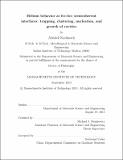Helium behavior at fcc-bcc semicoherent interfaces: trapping, clustering, nucleation, and growth of cavities
Author(s)
Kashinath, Abishek
DownloadFull printable version (29.19Mb)
Other Contributors
Massachusetts Institute of Technology. Department of Materials Science and Engineering.
Advisor
Michael J. Demkowicz.
Terms of use
Metadata
Show full item recordAbstract
He implanted into metals precipitates into nanoscale bubbles that grow into voids, degrading the properties of engineering alloys in nuclear energy applications. In this thesis, multi-scale modeling techniques and neutron reflectometry measurements are used to study the He trapping, clustering and growth of clusters at fcc-bcc interfaces. Choosing Cu-Nb as a model fcc-bcc interface, a predictive Cu-Nb-He interatomic potential is constructed using density functional theory. These calculations show that two-body radial forces are sucient to describe interactions of He with fcc Cu and bcc Nb. Atomistic simulations reveal that He is initially trapped in the form of stable, sub-nanometer platelet-shaped clusters and not bubbles at the Cu-Nb interface. This behavior occurs due to the spatial heterogeneity of interface energy: He wets high energy, heliophilic regions while avoiding low energy, heliophobic ones. Using these insights, the maximum He concentration that can be stored without forming bubbles at any interface in terms of its location-dependent energy distribution may be predicted. The modeling predictions are validated by neutron reflectometry measurements, which show that interfacial He bubbles form only above a critical He concentration and provide evidence for the presence of stable He platelets below a critical He concentration. This work paves the way for the design of composite structural materials with increased resistance to He-induced degradation by tailoring the types of interfaces they contain.
Description
Thesis: Ph. D., Massachusetts Institute of Technology, Department of Materials Science and Engineering, 2013. This electronic version was submitted by the student author. The certified thesis is available in the Institute Archives and Special Collections. Cataloged from student-submitted PDF version of thesis. Includes bibliographical references (pages 153-171).
Date issued
2013Department
Massachusetts Institute of Technology. Department of Materials Science and EngineeringPublisher
Massachusetts Institute of Technology
Keywords
Materials Science and Engineering.